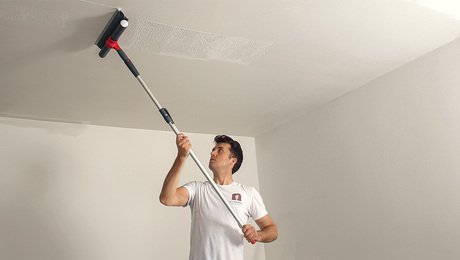Adding on a little bungalow behind the house. I’m wondering how to connect the sewer line into the existing line running from the house to the sewer main. The line is 4″ PVC and is buried about 2′ deep.
You can’t glue in a Tee, so how do you make the connection??
There is a vertical inspection riser nearby. Could I just connect into that??
Both the house and the add-on have concrete slabs. I have the ditch dug for the new 4″ line but no connections are glued yet.
PlaneWood by Mike_in_Katy (maker of fine sawdust!)
PlaneWood















Replies
You cut in and use what are called "no-hubs." These are the rubber couplers with a stainless clamp at either end. So, if you have to get into a line you first make up the tee that you're going to use. Cut 2 minimums, like 3 or 4 inches long and glue them to the inlet and outlet of the tee. Once this is done take the full length of the assembled tee and add 1/4". This is the amount of pipe you have to remove from the existing line. Now all you have to do is put a little dish soap on the couplers and slip them onto the ends of the cut existing line. Then, place the new tee in place, slide the couplers onto the tee to straddle the joint and tighten the clamps with a 5/16" nut driver. Now connect your new line to the side inlet and if you did everything else right you're good to go.
Dont forget to have your wife flush while u are hooking everything up.
Ethos,
You did a great job explaning how to make the connection. You should add that the verticle "inspection" pipe is probably a clean out... If it isn't, a clean out should be added. Also if the added drain from the new area drops too fast, there will be a probability of stoppage in the pipe. There is a code on this....
Ken
Hi Ken-
Several years ago I was working up a bid for a house that was in the process of switching from septic to city sewer. The house was approx. 300' from and 15' above the tie-in at the road. Sloping the pipe at 2% or thereabouts would have only dropped the line 6 feet or so. This realization had me ringing the phones of sanitary engineers in several surrounding towns.
In short, what I came up with was- Don't worry about it, just trench parallel to the slope and go.
Explanation: the bore of ABS or PVC is smooth and will stay that way, ie. will not corrode or corrade (be abraded by the flowing effluent.) This means that there should be little- if the install was done well- for solids to snag on and begin clogs. As I understand it, maintaing enough standing liquid to buoy floaters over the rough spots is critical with cast iron where too much pitch would have the fluid outpacing the solids, leaving them high and dry and adhering to irregularities and starting to build tenacious obstructions. In the above scenario, cleanouts every 100' would make dealing with something unusual, not a big deal.
I read an article in plumbing and mechanical magazine just recently talking about the myth of liquids out running the solids in a sewer that has to much pitch to it. Although I don't remember the exact science behind the theory, according to this article it is impossible to pitch the sewer line too much to make the two separate. Of course if your inspector does not believe this then you may be digging a new trench if he doesn't like what he sees.
Thanks Ethos, but....
Are the "minimums" just short pieces of the pipe that are to be glued into the ends of the Tee?
How long will the stainless steel bands last before rusting away? Lots of clay in the soil here.
PlaneWood by Mike_in_Katy (maker of fine sawdust!)PlaneWood
Why can't you connect into the existing sewer line? You can tie into the sewer line or vertical riser, but you need to use a whye and maintain min. 2% slope. Is riser connected at sewer with a whye if not you could have problems down the road. The more pitch you can provide to sanitary leed the better.
I am connecting into the existing line. But, the Tee or Yee cannot be glued in cause each end of the pipe (after cutting out the section) will be immovable.
PlaneWood by Mike_in_Katy (maker of fine sawdust!)PlaneWood
Got it. Go with the techinque Ethos explained short glue in stubs with Fernco (trade name) rubber bands. Use yee I wouldn't worry about clamps rusting by the time that happens rubber will have already seated and have a memory, backfill will hold in place and their really isn't pressure to cause fitting to seperate.
Transition of sewer lines that you describe (300' with 6' of fall), should be made with a 45 degree fitting and a length of pipe long enough to reach the main line. PVC is slick inside, but will not self clean if there is no water to wash the sediment out. If you exceed the 2% rule here, it won't pass insection. Beats me how our inspector can stand at the top of the trench and tell if there is two much or to little fall. If he thinks it is wrong, he will ask for a level shot. He may let a master plumber slide with a little less fall, but a home owner, never.